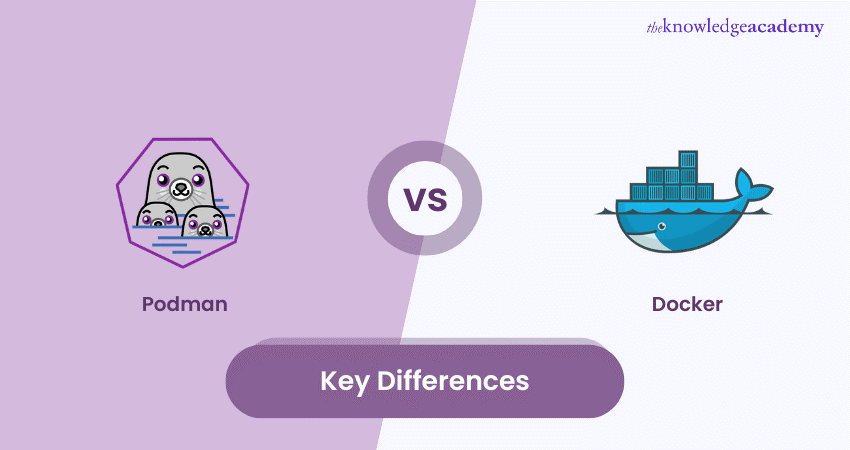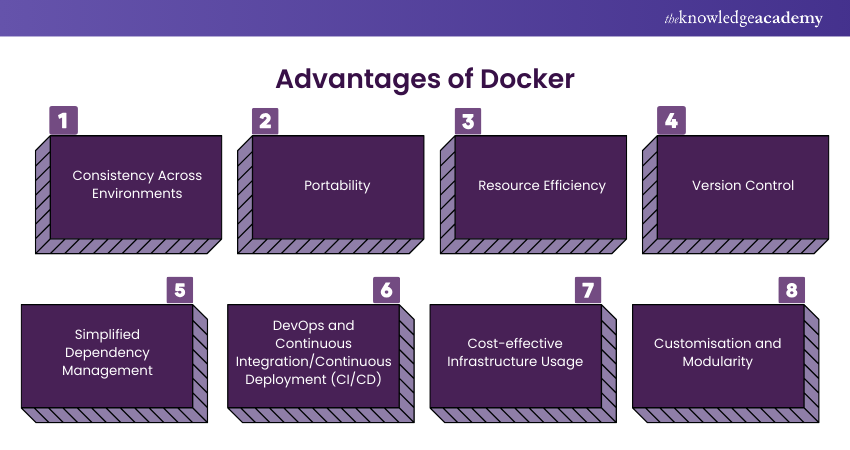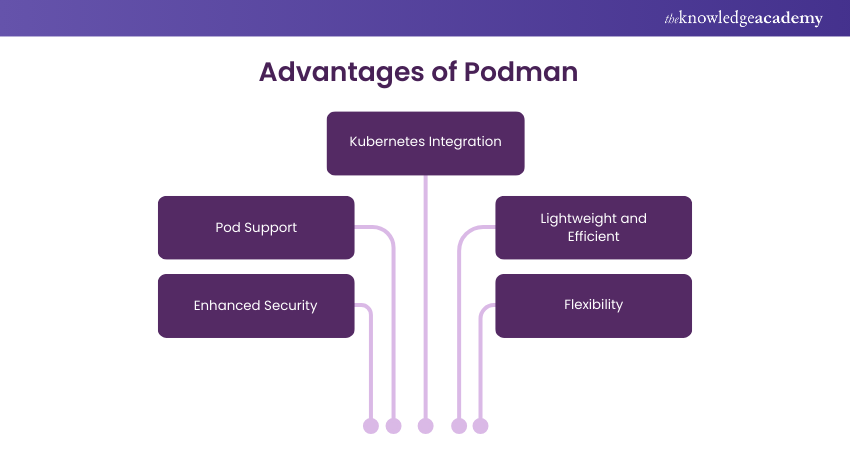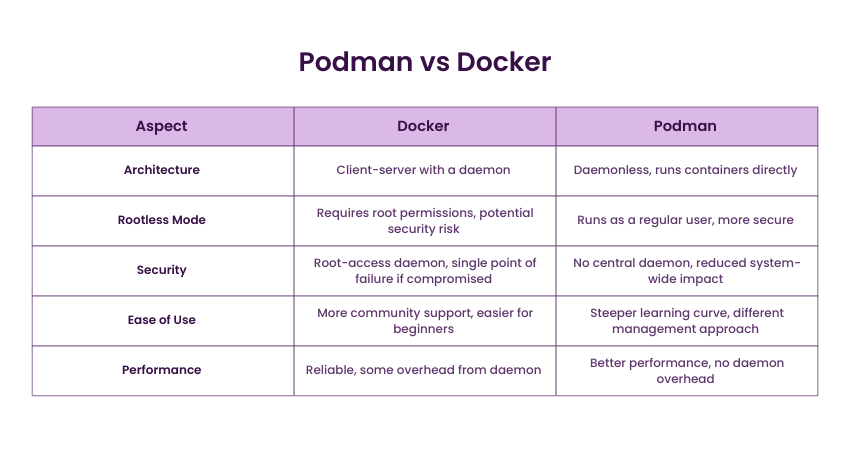We may not have the course you’re looking for. If you enquire or give us a call on 01344203999 and speak to our training experts, we may still be able to help with your training requirements.
We ensure quality, budget-alignment, and timely delivery by our expert instructors.

Are you curious about container management and wondering which tool to choose? Look no further! In this blog, we dive into the world of Podman vs Docker, two powerful tools for creating and managing containers. We discuss their key differences, similarities, and how each one functions.
Whether you're a developer seeking better security or a beginner looking for ease of use, understanding Podman and Docker helps you make an informed decision. Let's uncover what sets these tools apart and how they can enhance your container management experience.
Table of Contents
1) What is Docker?
2) How Does Docker Function?
3) Advantages of Docker
4) What is Podman?
5) How Does Podman Function?
6) Advantages of Podman
7) Podman vs Docker: What are the Differences?
8) Podman vs Docker: Key Similarities
9) Conclusion
What is Docker?
Docker is a platform that helps developers create, deploy, and run applications in containers. Containers are lightweight, portable, and isolated environments that contain everything needed to run a piece of software, including the code, runtime, and dependencies.
Docker makes it easier to manage and scale applications, as containers can run consistently across different environments. This helps developers avoid issues like "it works on my machine" because the container ensures a consistent environment.
Docker also includes tools for managing containers and images, which are blueprints for creating containers. It's widely used for developing, shipping, and running applications more efficiently.
How Does Docker Function?
Docker functions by using a combination of technologies to create, deploy, and manage containers. Here's a simple way of how Docker works:
a) Docker Engine: The Docker Engine is the core of Docker. It consists of a daemon, a REST API, and a Command-line Interface (CLI). The daemon runs in the background, managing containers, images, networks, and storage.
b) Docker Images: These are templates used to create containers. An image includes everything needed to run an application, such as the code, runtime, libraries, and settings. You can build your own images or use pre-made images from Docker Hub. Docker Image and Container work together, where the image serves as the blueprint, and the container is the running instance of that image.
c) Containers: Containers are lightweight, portable, and isolated environments created from Docker images. They share the host system's kernel but run independently. This isolation ensures that applications run consistently, regardless of the environment.
d) Dockerfile: A Dockerfile is a text file that contains instructions for building a Docker image. It defines the base image, application code, dependencies, and configurations. By running the Docker build, you create an image from the Dockerfile.
e) Docker Hub: It is a cloud-based repository where you can find and share Docker images. You can pull images from Docker Hub to use them in your projects or push your own images to share with others.
f) Networking: Docker provides various networking options to connect containers to each other and the outside world. This allows you to set up complex, multi-container applications that communicate seamlessly.
Advantages of Docker
Here are some of the key benefits of Docker:

a) Consistency Across Environments: Docker containers encapsulate an application and its dependencies, ensuring consistent behaviour in development, testing, and production environments. This consistency makes the software more reliable.
b) Portability: Docker containers are portable and can run on any system that supports Docker, regardless of the underlying infrastructure. This enables developers to build once and run anywhere, making it easier to migrate and scale applications.
c) Resource Efficiency: Containers are lightweight and share the host operating system's kernel. This reduces resource overhead compared to traditional virtualisation, making Docker highly efficient in terms of memory and CPU usage.
d) Version Control: Docker images are versioned and can be easily rolled back or updated. This helps manage and track changes to application configurations and dependencies.
e) Simplified Dependency Management: Docker simplifies the management of application dependencies. You can package all the required libraries and tools within a container image, eliminating compatibility issues and making it easy to set up development and testing environments.
f) DevOps and Continuous Integration/Continuous Deployment (CI/CD): Docker has become a cornerstone of the DevOps and CI/CD processes. It enables teams to automate testing and deployment pipelines, leading to faster and more reliable software delivery.
g) Cost-effective Infrastructure Usage: Docker allows for efficient utilisation of infrastructure resources. Containers can be densely packed onto a single host, reducing the number of physical or virtual servers required.
h) Customisation and Modularity: Docker supports custom images, allowing developers to create tailored containers with specific configurations and software packages. This modularity simplifies the management of complex applications.
What is Podman?
Podman is an open-source tool similar to Docker that is used for managing containers and container images. It doesn't require a central daemon, meaning it can run as a regular user without root privileges, enhancing security. Podman is compatible with Docker's Command-line Interface (CLI), making it easy for users to switch between the two.
It supports creating pods, which are groups of containers that share resources like networking and storage. This feature is particularly useful for Kubernetes environments. Podman is often favoured in environments where security and rootless operation are important.
How Does Podman Function?
Podman functions as a tool for managing containers without needing a central daemon. Here's a simple breakdown of how Podman works:
a) Daemonless Architecture: Podman doesn't rely on a background daemon. Each container process is directly managed by the Podman command, making it more secure and less resource-intensive.
b) Container Management: Podman allows you to create, run, and manage containers directly from the command line. It uses commands similar to Docker, making it easy for users to switch between the two tools.
c) Rootless Operation: Podman can run containers as a regular user without requiring root privileges. This enhances security by minimising the potential impact of container processes on the host system.
d) Podman Images: It uses the same container images as Docker. You can pull images from popular repositories like Docker Hub and use them with Podman without any modifications.
e) Pods: It supports pods, which are groups of containers that share the same network namespace. This feature is inspired by Kubernetes and helps in managing multi-container applications more efficiently.
f) Kubernetes Integration: Podman can generate Kubernetes YAML files directly from containers or pods, making it easier to transition from local development to a Kubernetes environment.
g) Compatibility with Docker: Podman is designed to be compatible with Docker. Most Docker commands work with Podman, and you can use Dockerfiles to build images with Podman.
Advantages of Podman
Here are some of the benefits of Podman:

a) Podman offers a more secure environment for running containers. Each container operates within the user’s permissions, minimising potential security risks.
b) Pod Support: Podman supports the concept of pods, allowing users to group multiple containers that share the same network namespace. This makes it easier to manage complex, multi-container applications.
c) Kubernetes Integration: Podman can generate Kubernetes YAML files from containers or pods, facilitating the transition from local development to a Kubernetes-based production environment.
d) Lightweight and Efficient: By not running a central daemon, Podman reduces system resource usage, making it a lightweight and efficient option for container management.
e) Flexibility: Podman offers flexibility in container management, allowing users to handle containers directly from the command line with similar commands to Docker, simplifying the learning curve for new users.
Podman vs Docker: What are the Differences?
Here are the key differences:

Architecture
Docker uses a client-server architecture. This means Docker has a daemon (server) that runs in the background and a client that communicates with this daemon to manage containers. The daemon handles all container operations, which can simplify management but also centralises control and processing.
In contrast, Podman is daemonless. It doesn't have a background server running. Instead, it runs containers directly from the command line. This means each container process is a direct child of the Podman command, which can reduce overhead and simplify security management.
Rootless Mode
Podman can run containers as a regular user without needing root (administrator) permissions. This makes it more secure because running as a regular user reduces the risk of system-wide changes. Users can manage containers within their own user space, minimising potential security vulnerabilities.
On the other hand, Docker requires root permissions to run, which can be a security risk. The Docker daemon needs root access to manage containers, creating a single point of failure that, if compromised, could affect the entire system.
Security
Podman is considered more secure because of its rootless mode and lack of a central daemon. Each container runs as a child process of the user that started it, adding an extra layer of security. This user-based approach means that container operations are confined to the permissions of the user, reducing the risk of system-wide impact.
In contrast, Docker relies on its daemon, which needs root access, making it potentially less secure. If the Docker daemon is compromised, it can potentially give an attacker full control over the host system, posing significant security risks.
Ease of Use
Docker has been around longer and has more community support and extensive documentation, making it easier for beginners. The Docker ecosystem includes numerous tutorials, forums, and resources that help new users get up to speed quickly.
On the other hand, Podman is catching up quickly but might have a steeper learning curve for new users. While Podman offers compatibility with Docker commands, new users might find the lack of a central daemon, and different management approaches may require some adjustment.
Performance
Podman can potentially offer better performance since it runs without a central daemon, reducing overhead. Each container operates independently, which can lead to more efficient resource utilisation and faster startup times.
In contrast, Docker's performance is generally reliable but may be slightly affected by the daemon's resource usage. The centralised management of containers through the daemon can introduce some performance overhead, particularly in resource-constrained environments.
Learn the latest DevOps practices with our Certified DevOps Professional (CDOP) Training – Join today!
Podman vs Docker: Key Similarities
Podman and Docker are both popular tools for managing containers. Despite their differences, they share several key similarities. Here are some of them:
a) Container Management: Both Podman and Docker allow you to create, run, and manage containers, which are isolated environments for running applications.
b) Image Compatibility: Both tools use the same container images. You can pull and run the same images from container registries like Docker Hub with either Podman or Docker.
c) Command Line Interface (CLI): Podman and Docker have similar CLIs. Many commands you use in Docker, like Docker run and Docker pull, work the same way in Podman (e.g., Podman run, Podman pull).
d) Orchestration Support: Both tools support container orchestration systems like Kubernetes. You can use containers created with either tool in a Kubernetes cluster.
e) Open Source: Podman and Docker are both open-source projects. This means you can freely use, modify, and contribute to their source code, benefiting from community collaboration and improvements.
Conclusion
Both Podman and Docker are powerful tools for managing containers, each with its own strengths. Podman offers enhanced security and rootless operation, while Docker provides a well-established and user-friendly environment. Understanding the key differences between Podman vs Docker helps you choose the best tool for your needs. Whether you prioritise security or ease of use, both options support container management effectively, making them valuable assets in modern software development.
Learn to streamline development processes with our Kubernetes Training – Join today!
Frequently Asked Questions
What is the Difference Between Docker API and Podman API?

The Docker API is a set of HTTP endpoints used by Docker clients to interact with the Docker daemon to manage containers. Podman, on the other hand, does not have a central daemon, so it uses a different API for managing containers directly from the command line.
Is Podman 100% Compatible with Docker?

Podman is designed to be largely compatible with Docker, supporting many of the same commands and container images. However, it is not 100% compatible; some features and workflows may differ, especially due to Podman’s daemonless architecture.
What are the Other Resources and Offers Provided by The Knowledge Academy?

The Knowledge Academy takes global learning to new heights, offering over 3,000 online courses across 490+ locations in 190+ countries. This expansive reach ensures accessibility and convenience for learners worldwide.
Alongside our diverse Online Course Catalogue, encompassing 19 major categories, we go the extra mile by providing a plethora of free educational Online Resources like News updates, Blogs, videos, webinars, and interview questions. Tailoring learning experiences further, professionals can maximise value with customisable Course Bundles of TKA.
What is The Knowledge Pass, and How Does it Work?

The Knowledge Academy’s Knowledge Pass, a prepaid voucher, adds another layer of flexibility, allowing course bookings over a 12-month period. Join us on a journey where education knows no bounds.
What are Related Courses and Blogs Provided by The Knowledge Academy?

The Knowledge Academy offers various DevOps Certification, including the Certified DevOps Professional (CDOP) Course, Kubernetes Training, and Docker Course. These courses cater to different skill levels, providing comprehensive insights into Information DevOps Engineer Salary.
Our Programming & DevOps Blogs cover a range of topics related to DevOps, offering valuable resources, best practices, and industry insights. Whether you are a beginner or looking to advance your Docker knowledge, The Knowledge Academy's diverse courses and informative blogs have got you covered.
Upcoming Programming & DevOps Resources Batches & Dates
Date
 Docker Course
Docker Course
Fri 11th Apr 2025
Fri 13th Jun 2025
Fri 15th Aug 2025
Fri 10th Oct 2025
Fri 12th Dec 2025






 Top Rated Course
Top Rated Course



 If you wish to make any changes to your course, please
If you wish to make any changes to your course, please


